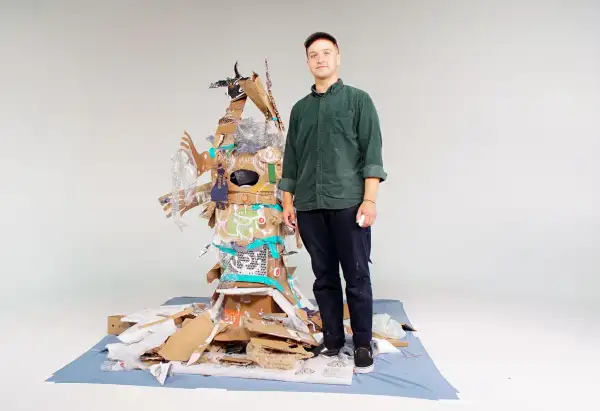Watch an Artist Turn 66 Pounds of Meal-Kit Trash Into a 6-Foot Garbage Demon

It’s often said that one man’s trash is another man’s treasure. But what would you do with more than 60 pounds of trash?
After testing out six home delivery meal-kit services, Money was left with over 130 pieces of trash and recyclables—ranging from the boxes themselves to dozens of little plastic bottles and bags that once held garlic, veggies, and sauces.
Once we threw out the smelly bits (leftover food, meat packaging and containers holding dairy products), Money had 66 pounds of trash. And while most of the meal kit services will tout that their items are recyclable, it can be a lot of work for the average consumer — Money found that only about 30% of the items can be recycled in a majority curbside programs.
That’s because most of the plastic items are labeled with the plastic recycling symbol #7. Because the material is a mixture of different types of plastic resins, most curbside recycling programs will not accept them. For example, the giant foil and plastic liner that Blue Apron uses to keep its boxes cool during the delivery process is labeled #7, and therefore will be more difficult for most people recycle (but the company does give customers the option to ship back their leftovers and Blue Apron will handle recycling).
Faced with a mountain of our own trash, Money decided to get creative. We asked Nick Mahan, a Brooklyn-based artist, to create a 3D sculpture. We gave him 90 minutes and free reign, the only guideline being that we wanted to use as much of the trash as possible.
Mahan crafted a nearly six-foot tall humanoid with two demon heads, saying that he felt his creation was a statement “demonizing the amount of trash people produce.”
Don’t have any artists hanging around? Don’t worry, here are 9 ways to reuse your meal-kit leftovers—and some will even save you money!
The Box
- Moving can be a hefty expense. Boxes at Home Depot sell for a little over a dollar a box. If you’ve been saving your meal-kit boxes throughout the past year, then, you’re looking at a savings of around $50. Boxes can also be used to store photo albums or off-season clothing, instead of purchasing storage boxes.
- Filing boxes at Staples cost around $20. Turn that box that once held your dinner into a home for your tax returns.
- Cut up that meal-kit box and use the cardboard sides as signage at your next yard sale, instead of buying poster board ($3 for 10 sheets).
- Use the box as a cat bed, which can cost between $10 and $30.
Ice Packs
- Ice packs cost around $4 on Amazon. Instead, start using those ice packs in your brown-bagged lunches, or bring them along with you to a beach picnic. If kept in your freezer, they can also be used to alleviate pain or swelling from a minor injury.
Brown Bags
- Pack your lunch in a meal kit box’s many brown bags, and save the $16 you would pay for a pack of 100 brown bags on Amazon.
Plastic Baggies
- Store tights or pantyhose in the plastic baggies to avoid tears and keep drawers organized, saving $5 for Ziplock baggies at Amazon.
- Punch holes in the non-zippered side of a plastic bag and put it in your or your children’s three-ring binders to hold pens and pencils, and save $7.50.
Plastic containers
- Use your meal-kits little plastic containers to store shampoo, conditioner or lotion when you’re traveling, and save around $6.